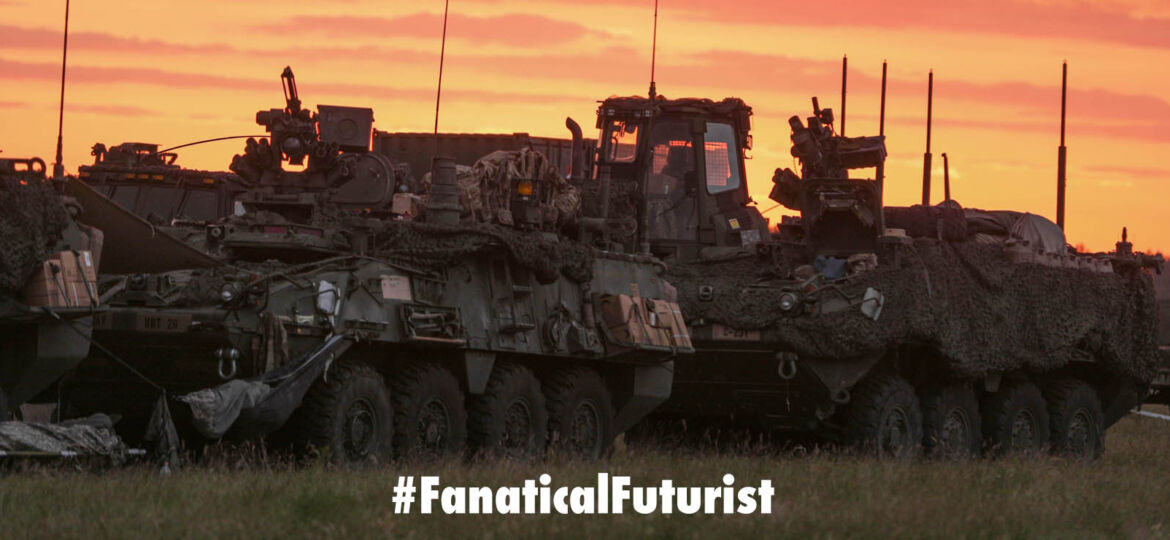
WHY THIS MATTERS IN BRIEF
The future of combat is drones and hypersonic weapons systems, so you need a new defensive weapon to counter than and light’s fast, cheap, and deadly.
 Love the Exponential Future? Join our XPotential Community, future proof yourself with courses from XPotential University, read about exponential tech and trends, connect, watch a keynote, or browse my blog.
Love the Exponential Future? Join our XPotential Community, future proof yourself with courses from XPotential University, read about exponential tech and trends, connect, watch a keynote, or browse my blog.
After years developing some of the world’s first combat ready direct energy weapons, or laser weapons to sci-fi fans, and a year or so on from knocking drones out of the sky with laser weapons and announcing it was going to be the first to deploy laser weapons on US Army Stryker vehicles Lockheed Martin has successfully demonstrated its ruggedised 50-kW tactical laser weapon on a Stryker, the company said in a press release.
A laser-powered weapon is high on the priority list for many countries as the dynamics of warfare have rapidly changed in the past few years thanks to the development of hypersonic weapons systems and drone swarms. Instead of looking to buy more sophisticated and expensive attack options, adversaries are now relying on cheap-to-build drones that can be used in large numbers.
Get up to speed fast!
The most recent example has been the Russian invasion of Ukraine. After months of attacking with tanks and aircraft, Russia has now switched to Iranian drone swarms to target crucial infrastructure. Although the US supports the Ukrainian cause with the best air defense system in its arsenal, the high cost of operating the missile-based system begs the question of whether it is financially viable in the long run.
A laser-based weapon is an effective tool against smaller Uncrewed Aerial Systems (UAS), but with increasing power can be used with larger aircraft as well. The US Army, which has been working in this area, has commissioned 50-kW weapons so far but is also considering a 300-kW weapon as well.
In addition to their ability to operate from land and at sea, the greatest benefit of a laser-powered weapon is the unlimited ammunition it has in its kitty, as long as the energy source is secured. This allows the weapon to be deployed at remote locations and even highly contested environments.
The DEIMOS system from Lockheed Martin is a 50-kW laser weapon designed to be integrated into the Stryker combat vehicles used by the US Army. When equipped, the weapon is expected to deliver directed energy capability to target UAS, rotary winged aircraft, rockets, artillery, and mortar as part of the US Army’s Directed Energy Maneuver-SHOrt Range Air Defense (DE M-SHORAD) mission.
The first light demonstration, completed recently, verified that the laser’s optical performance is in line with the system design parameters. The company claims to use a Spectral Beam Combination (SBC) architecture that is low-cost and allows power to be scaled while retaining the beam quality fired by the lasers.
Last year, the company demonstrated its Layered Laser Defense (LLD) capability, which defeated two surrogate missiles at tactically relevant ranges. The LLD capability has many commons with the DEIMOS system, such as the requirement of just one operator to target and destroy aerial threats, as well as easy integration into different platforms.
The company press release said that Lockheed Martin can deploy its LLD capability to the Stryker platform as it looks to expand its DEIMOS test program this year. The US Army’s Rapid Capabilities and Critical Technologies Office (RCCTO), which is leading the DE M-SHORAD prototyping, is expected to transfer the program to Program Executive Office (PEO) Missiles & Space in 2024, as Lockheed Martin completes its field integration tests.
“The 50 kW-class laser weapon system brings another critical piece to help ensure the US Army has a layered air defense capability,” said Rick Cordaro, Vice President at Lockheed Martin Advanced Product Solutions. “DEIMOS has been tailored from our prior laser weapon successes to affordably meet the Army’s larger modernization strategy for air and missile defense,” he added in the press release.
















